|
The Soils of War
The real agenda behind agricultural reconstruction
in Afghanistan and Iraq
by GRAIN
Barcelona, Spain
GRAIN is an international non-governmental organisation (NGO) which promotes the sustainable management and use of agricultural biodiversity based on people's control over genetic resources and local knowledge. Numbered references are linked to a new browser window for easy viewing.
Introduction
|
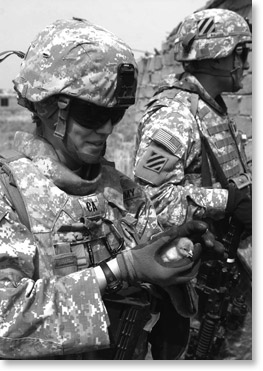 |
|
Basic inputs from Iraqi farmers -- seeds, poultry and so on -- are brought from outside and distributed through U.S. military regiments. Photo by U.S. Army Photo: Sgt. David Turner.
|
|
 |
|
Afghanistan. Click to see larger version.
|
|
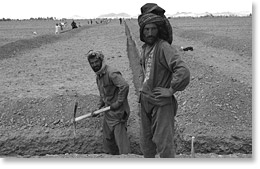 |
|
Afghan workers preparing fields of the U.S. Agriculture Center in Shindand.
|
|
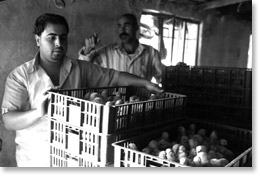 |
|
Basic inputs from Iraqi farmers -- seeds, poultry and so on -- are brought from outside and distributed through U.S. military regiments. Photo by U.S. Army Photo: Sgt. David Turner.
|
|
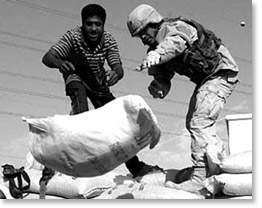 |
|
The U.S. army helping to distribute imported fertiliser. Photo by U.S. Army Photo: Spc. Erik LeDrew.
|
|
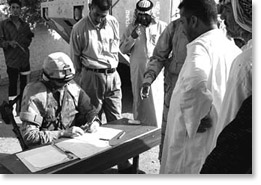 |
|
The U.S. army signing up Iraqi farmers for the farmers' union. Photo by U.S. Army Photo: Spc. Erik LeDrew.
|
In this Briefing, we look at how the US’s agricultural reconstruction work in Afghanistan and Iraq not only gives easy entry to US agribusiness and pushes neoliberal policies, something that has always been a primary function of US development assistance, but is also an intrinsic part of the US military campaign in these countries and the surrounding regions. Seen together with the growing clout that the US and its corporate allies exercise over donor agencies and global bodies -- such as the World Bank, the UN Food and Agriculture Organisation (FAO) and Consultative Group on International Agricultural Research (CGIAR) centres, which influence the food and farm policies adopted by the recipient countries -- this is an alarming development. These are not unique cases born from unusual circumstances, but constitute a likely template for US activities overseas, as it continues to expand its “war on terror” and pursue US corporate interests.
Asia has seen its fair share of disasters in recent years, both man-made and natural -- floods, cyclones, tsunamis, earthquakes, war. After each calamity, efforts are made to put the pieces back together. But “aid” from outside often comes with a political or even a military agenda that aims much more to refashion countries to satisfy powerful interests than actually to rebuild the affected communities. Humanitarian aid is regularly conditional on the adoption of neoliberal policies, and, perhaps more troubling, there has been a recent trend in the case of war to interweave this aid, classified as “reconstruction”, closely with the military machinery of the invading powers. In Afghanistan, where US President Obama is sending an additional 17,000 US troops, and Iraq, the testing grounds for this militarised aid, the distinction between the US’s civilian and military activities has been completely, and deliberately, blurred.
Afghanistan: food and bombs
When the US began its campaign of bombing Afghanistan in 2001, one of its first targets was the Soviet-built Shindand airfield in the west of the country, near the border with Iran. A year later, the US took control of the airfield, one of the largest in the country, amid accusations that it intended to use the site as a possible base for operations against Iran. Today the area around Shindand remains a scene of intense warfare between US/NATO and Taliban forces, with civilians caught in the middle.
On 21 August 2008, US planes taking off from the Shindand airfield bombarded a village in Shindand District, killing at least 88 innocent civilians. When protesters later took to the streets of the regional city of Azizabad, the Afghan National Army opened fire on the crowd, leaving several people wounded. The protest had erupted after officials from the central government came with food aid for the affected families. “They destroyed our houses, killed dozens of people and they still send us wheat?” said Hamidullah, a local resident who took part in the protests. [1]
In the war in Afghanistan, bombs and food are a package deal. At the very airfield from which the US planes launched their deadly attack, US forces had established an agricultural training centre just months before. “The agricultural centre has many positive effects for both the troops and the local population,” says a leader with the US Special Forces civil affairs team. “This allows us to build a rapport with the villagers through education and employment; therefore, they are given a reason to think twice about allowing the anti-Afghan forces to step in and influence their lives in a negative way. The presence of this agricultural centre is a security measure in and of itself.” [2] Its explicit objective is to give a positive spin to the US occupation.
The US officials say that the centre will eventually build up agricultural production for export in the area and wean local farmers away from producing poppies -- a crop that still provides more security and income to farmers than the millions of dollars in foreign aid, so little of which trickles down to them. The centre is equipped with laboratories, classrooms, several fish ponds with hatcheries, vineyards and orchards. A weather station and drip irrigation system are planned. All of it is run by the US military.
To the south-east, USAID contracted the US firm Chemonics Inc. to build an agriculture centre outside Lashkar Gah, a city in the province of Helmand, another area of intense conflict with the Taliban. Chemonics is an international firm that specialises in private sector development and agriculture, and operates under the slogan “to catalyse agribusiness”. [3] It was founded in Washington in 1975, and since then USAID has been its major client. [4] According to its president, Richard Dreiman: “We at Chemonics are proud to be part of Afghanistan’s agricultural and agribusiness renaissance.” [5] Chemonics says that the location originally chosen for the agriculture centre, in a farming area, was rejected; they were instead “instructed” for “strategic military and security considerations” to establish it at the Lashkar Gah airfield, which is under the control of the UK military. [6] It is clear that the line between the military and aid objectives has been blurred -- and purposely so.
Thirty years ago, when Afghanistan was a net exporter of food, Helmand was the country’s breadbasket. The US proclaimed after the invasion that by 2007 it would once again make the country self-sufficient in food. Today in 2009 that goal is as distant as ever, with Afghans still dependent on food imports and foreign assistance. This is largely because the war has continued, devastating the country’s agriculture. Rather than genuinely helping Afghans to recover their old farming skills, the agriculture centres provide a veneer of agricultural reconstruction to a military mission that is destroying Afghanistan’s food systems. They are an attempt to legitimise the military bases of an occupying power.
The Provincial Reconstruction Teams (PRTs) (See Box 1: The Agricultural Advisers) that the UK and US deploy in the Afghan countryside with increasing frequency serve a similar purpose to the agriculture centres. A PRT typically consists of 60-250 military personnel, a USAID field officer and a US State Department political officer. USAID says that there are about 25 PRTs currently operating in Afghanistan. According to USAID:
“PRTs in Afghanistan are key instruments through which the international community delivers assistance at the provincial and district level. As a result of their provincial focus and civilian and military resources, PRTs have a unique mandate to improve security, support good governance, and enhance provincial development. The combination of international civilian and military resources also allows the PRT to have wide latitude to implement their mandate .... PRTs seek to establish an environment that is secure and stable enough for the operation of international and Afghan civilian agencies to provide development support. Due to their unique composition, PRTs are also able to deliver development and support to less secure areas. USAID’s programs attempt to work with PRTs to deliver services in less secure or underserved areas of Afghanistan.” [7]
Some of the PRTs are called Agricultural Development Teams, and they have a specific agricultural mission. Aside from the ridiculous intent to teach Afghan farmers about how they do things in Iowa or Texas, and the provision of free wheat seeds to convince farmers to abandon poppy cultivation, these teams, composed mainly of soldiers from the National Guard, also make critical contributions to military operations. “It helps in the military kinetic part because it involves cooperation of the local population, and intelligence resources can be brought to bear”, explains Army Major-General King E. Sidwell. “It makes friends when you might not otherwise be able to make friends.” [8]
Agribusiness grows on the battlefield
The support between the military and agricultural work runs both ways. While agricultural reconstruction facilitates US/NATO military operations, the military operations push forward the agenda of US and other foreign-based agribusiness corporations by creating a context where they can easily put pressure on the government to adopt neoliberal policies. The war provides these corporations with both a lucrative short-term market in the blossoming “reconstruction” industry (see Box 2) and an opportunity to integrate Afghanistan into their global production networks and markets in the long term.
Seeds are at the centre of these processes. Those “rebuilding” Afghanistan’s agriculture zoomed in on exactly that. In 2002 a global multi-partner exercise with 34 organisations was brought together under the banner of the CGIAR, with US and Australian funding. This Future Harvest Consortium to Rebuild Agriculture in Afghanistan (FHCRAA) lasted about a year, within which time it imported and distributed several thousand tonnes of wheat seed from Pakistan and set up seed multiplication programmes for varieties of other crops that it brought in from the International Centre for Agricultural Research in the Dry Areas (ICARDA) in Syria. [9]
The Consortium and other CGIAR-led initiatives have completely bypassed the rich heritage of farmers’ varieties in Afghanistan, which would have provided the basis for genuine agricultural reconstruction. According to an ICARDA survey conducted in 2002, neither rain-fed rice varieties nor rain-fed and irrigated wheat varieties that have been supplied by the aid organisations have included any Afghan genetic materials. The authors of the survey concluded that Afghan wheat farmers are “on their own when it comes to replicating and reselecting local variety seed”. [10]
Afghanistan has instead been deluged with all manner of foreign seed varieties, some of which have come through projects with foreign seed companies seeking to test their varieties in a potential future market (see Box 3). Concerns were raised early on about the indiscriminate importing of seeds and the disregard of local seeds, prompting the FAO, [11] ICARDA [12] and the Afghan Ministry of Agriculture to propose a Code of Conduct for seed aid in 2002. But any concern for farmers’ seeds has been overrun by the insistence of the US and EU on crafting a seed industry in Afghanistan allied to their larger political agendas. Essentially this means building up a few local seed companies that can initially serve as a conduit for seed aid, and later, if the US wins the war, open the door to foreign seed companies and agribusiness.
As in the rest of the world, a private seed industry in Afghanistan requires a legislative framework that creates a commercial seed market. This is done through laws that make proprietary seed sale the norm, forcing farmers to buy rather than save or share such seeds, with little protection for farmers’ own local varieties and seed practices. [13] Thus, on 13 September 2005, by way of a process led by the FAO and the EU, the Agriculture Ministry adopted a National Seeds Policy which, while seeming to defend the seed-saving rights of farmers, endorsed monopoly rights for seed companies that would make it illegal for farmers to exchange or sell commercial seeds:
“Farmers will maintain their right to use, exchange, share or sell their farm-saved seed between themselves without any restriction and will have the right to continue using any varieties of their choice without being hampered by the system of compulsory registration provided they do not commercialise production emanating from proprietary varieties.” [14]
A national seed law soon followed, the draft of which prohibits the sale of non-certified seeds unless they conform to minimum standards of germination, purity and labelling. As small farmers might find it difficult to comply with these requirments, it could affect the sale and exchange of farmers' seeds. [15]
With this legal framework in place, the first private company producing and selling wheat seeds was inaugurated in Bamyan province in Central Afghanistan in August 2006. [16] Other companies have since followed, and in October 2008 an Afghanistan National Seed Association (ANSA), headed by the chief executive of a private Afghan seed company, was created in Kabul with FAO support. [17] To call it a national industry is a bit of a stretch. Afghanistan’s private seed companies are kept afloat by outside donors. In 2008, for instance, USAID and the UK government’s Department for International Development (DFID) contributed US$3 million each to an EU Seed Project that provides loans for the purchase of certified wheat seed. What is more, the main activity of the seed companies is to produce seed for the foreign donor programmes or military operations. Most if not all of their seed sales are through contracts with foreign agencies, as part of poppy eradication programmes or military PR exercises.
ANSA is not the only game in town. The Taliban runs its own seed supply networks, with a similar strategy of winning the loyalty of local farmers. The US Army claims that the Taliban control a large wheat-seed farm in Ghazni province and distributes seed to farmers in areas under their control. A US National Guard Agribusiness Development Team told the Dallas Morning News that it plans to build another wheat-seed farm nearby to “free Ghazni’s wheat farmers from Taliban-approved suppliers”. [18]
Either way -- Taliban seed or US Army seed -- the seed is certainly not “free”. Both come with heavy political agendas, backed by armed forces, that have little to do with the interests of Afghanistan’s small farmers. Getting their own seeds back into the hands of these farmers is the only real way that they will find their freedom.
One justification for introducing a range of cash crops is to provide alternatives to the cultivation of opium poppies for the global drug trade. But, while poppy farming is flourishing, few farmers seem interested in the alternatives. It is not hard to understand why: a poppy farmer makes much more money -- approximately ten times more -- than a wheat farmer. One possible solution, which is being promoted by an Australian scientist from the Canberra-based Commonwealth Scientific and Industrial Research Organisation, jointly with the US San Diego State University’s Homeland Security Programme, is to legalise the production of poppies for biodiesel production. Farmers would plant a variety of poppy seed that has been genetically modified to have a high oil content and not to contain narcotic properties. Leading donors are also pressing for more economically viable “alternative” crops and “improved” varieties to offer farmers (see Box 3).
Rebuilding Iraq
It is ironic that any mention of rebuilding food and farm systems in Iraq -- known as the cradle of agriculture -- has to begin with numerous references to the US. However, in today’s context it is important to point out that Iraq has long been important to the US as a market for its agricultural commodities. While it is true that the US has long-term interests in developing such a market in Afghanistan, Iraq is already the number one destination for its hard red winter wheat exports and a top destination for its rice. [19] It is a US$1.5bn market that wasn’t accessible to US companies before the invasion, because of the sanctions. [20] Indeed, controlling the development of Iraq’s agriculture and food systems was so important to the US that in the early years of its occupation it brought in Dan Amstutz, an ex-Cargill executive and a veteran insider with US trade delegations, to be in charge of this sector. [21]
The US came into Iraq with a heavy agenda for reforming all sectors of its economy, not just agriculture. However, the US’s Coalition Provisional Authority could not enforce its neoliberal reform programme as rapidly as it wanted to, because it was subject to a series of constraints: the laws of the Geneva Convention, the practical problems of a lack of interest by investors, and the desperate need for some form of organisation to cater to the basic needs of the Iraqi people. Even so, the CPA managed to enact a harsh set of neoliberal policies that had a major impact on the country. [22] Indeed, the impact of the reforms, combined with the continuing war, has been so catastrophic that by January 2009 the Chairman of the Iraqi Union of Industries confirmed that 90 per cent of the country’s industries had closed since 2003. [23]
In respect of the agricultural sector more specifically, the US has implemented a blueprint similar to the one already described in relation to Afghanistan, albeit on a larger scale and with more flagrant profiteering by US companies. In one of its orders, the CPA abolished agricultural subsidies and opened up the agricultural market. Not surprisingly, the country was flooded with cheap imports and local food production collapsed. Just as in Afghanistan, changes in seed laws were seen as crucial. However, whereas in Afghanistan it was at least the central government that enacted the new laws, in Iraq farmers’ rights to save seeds were struck down by the infamous Order 81 during the last days of the US’s Coalition Provisional Authority’s rule. [24]
Dan Amstutz was put in charge of the USAID’s Agriculture Reconstruction and Development Program for Iraq (ARDI). This work, which was managed by one of USAID’s most trusted private contractors, Development Alternatives Inc. (DAI), focused on accelerating “the transition from a command-and-control production and marketing system to a market-driven economy where farmers and agribusinesses are able to take risks and realize profits”. [25] At the top of ARDI’s list was wheat, Iraq’s most important food crop. In the field, ARDI’s work with wheat focused on the import, multiplication and distribution of certified wheat seed. [26] Those efforts seem to have had little impact. During ARDI’s three years, Iraq’s national wheat production dropped from 2.6 million tonnes in 2002 to 2.2 million tonnes in 2006 (despite a doubling in the area sown to wheat) and the national average yields for wheat plunged over those same years from 1.6 tonnes per hectare to 0.6 tonnes per hectare. [27] But ARDI was also playing a political game with wheat that was part of a larger US shock-therapy strategy for the Iraq economy and likely to have been of more interest to US agribusiness: its central objective was to liberalise and privatise Iraq’s wheat sector, and its Public Distribution System in particular. [28] While the chaos following the US invasion made an immediate sell-off or dismantling of Iraq’s wheat sector impossible (and illegal under the Geneva Convention), ARDI tried to push the Iraqis down the alternative path of neoliberal reforms that could arrive at the same ends while sidestepping political sensitivities and immediate practical problems. [29] Some of this privatisation is now being implemented in Iraq through the “International Compact with Iraq” -- a five-year plan negotiated by the Iraqi government with the World Bank, the US and other major donors. [30] Whatever the eventual outcome, the combined devastation of Iraq’s wheat production and the opening of its wheat markets to US imports, both brought about by the US invasion, has yielded billions of dollars for US grain companies.
When ARDI came to a close in 2006, USAID launched two new programmes -- a US$343 million Inma Agribusiness Program [31] and Izdihar (Iraq Private Sector Growth and Employment Generation). [32] Both programmes are being carried out by the Loius Berger Group Inc., one of the world’s largest infrastructure and development consultancies, and they are designed to prepare the way for agribusiness investment in the food industry.
Yet, like similar programmes in Afghanistan, these agriculture reconstruction programmes also serve a military function and are immersed in military operations. Of the US$250 million of “reconstruction” funds that the US has so far spent on the 581 agricultural projects that it has either proposed, planned or completed since the beginning of the invasion, more than 97 per cent of the projects have been paid for with funds from the Commanders’ Emergency Response Program (CERP), which is managed by the “Multi-National Corps-Iraq”. Only 2.4 per cent of these projects have been funded by the Iraq Relief and Reconstruction Fund, which is supervised by the US’s Special Inspector General for Iraq Reconstruction. CERP was initially funded by way of the cash and assets that the US military seized from the former Iraqi government. After the US military had spent these seized funds by early 2004, just before the Coalition Provisional Authority came to an end, the US decided to keep CERP going with appropriations from the US government. Of the 552 agricultural reconstruction projects the US has started in Iraq, the Multi-National Corps-Iraq have managed 536, the US Army Corps of Engineers have managed six, and USAID has managed only ten. [33] Funding for agriculture reconstruction in Afghanistan is also dominated by a similar CERP, meaning that, in both cases, it is the military that ultimately decides which projects get done.
The USAID and other so-called civilian programmes in Iraq work with Provincial Reconstruction Teams (PRTs) -- modelled on the PRTs that were first set up in Afghanistan. According to the US Embassy in Iraq: “Established in Iraq in 2005 and inaugurated by Secretary Rice in November that year, the Provincial Reconstruction Team (PRT) initiative is a civilian-military inter-agency effort that is the primary U.S. Government interface between U.S., Coalition partners and provincial and local governments throughout all of Iraq’s 18 provinces.” [34]
A December 2008 report by the United States Institute of Peace, “an independent, nonpartisan, national institution established and funded by Congress”, [35] provides more details about how the PRTs relate to the US military mission in Iraq, and is worth quoting at length:
“PRTs tend to play a supporting, advisory role for the military, providing them with civilian expertise they would not otherwise have access to and offering suggestions on how to shape operations. As one member of a PRT working in a counter-insurgency environment in Baghdad said, ‘The military is the blunt instrument; we provide the fine tuning.’ Nonetheless, in counter-insurgency environments, the military has the unambiguous lead, and freely ignores PRT’s advice if, in their judgment, security concerns dictate. ... PRT’s report to Baghdad and Washington about political, economic and security developments in their provinces -- an obviously beneficial but rarely discussed function. Senior policymakers and military officials highly value the information they get from the PRTs. On a political level, these officials analyze winners and losers and project trends for political development in their provinces. PRT members also monitor security flashpoints and scout for the military, a particularly useful role in areas where the military has a light footprint. On an economic level, officials in Baghdad said that were it not for the PRTs, they would have little idea of how much money was being spent by Iraqi ministries. (The Iraqi Ministry of Finance, for both technical and political reasons, is unable or unwilling to provide this information, but this information is readily available to the PRTs.) ... PRTs are valuable diplomatic representatives to provincial governments. It is highly unusual, if not completely unprecedented, for the U.S. to have independent diplomatic contacts with such low-level and numerous governmental entities in a foreign country. In the current environment in which many U.S. interests depend on the course of Iraqi political development, it is valuable for the U.S. to have these points of diplomatic contact to nudge Iraqi politics in a direction that serves Washington’s interests.” [37]
It now seems likely that, under President Obama, the PRTs importance to the US mission will greatly expand. According to a report in the New York Times on 3 December 2008, “Pentagon planners” are proposing “relabeling some units, so that those currently counted as combat troops could be ‘re-missioned’, their efforts redefined as training and support for the Iraqis”. [38] As a result of this ploy, the Pentagon intends to keeps as many as 70,000 troops in Iraq beyond 2011, which is the date established in the US--Iraqi Status of Forces Agreement (SOFA) for the complete withdrawal of all combat troops. If this ruse goes ahead, the distinction between the military and aid workers will be completely blurred. Moreover, by agreeing to this subversion of SOFA, the US President Obama has, in practice, given up on his electoral pledge to withdraw US combat troops from Iraq within 16 months. [39] This is hardly a clean break from the policies of the Bush administration.
It is a huge challenge for farmers to organise in such a setting where choices are limited and where farmers are not themselves in control of their own futures. Both the Oil-for-Food programme, which banned purchase of local produce, and the large-scale importation of food after the invasion when the markets were opened up to cheap imports devastated Iraqi farmers. Moreover, farmers’ organisations are now being set up by occupying forces to facilitate their “reconstruction” work. In Iraq, the US Army is directly involved in re-establishing the “farmers’ unions” that were formerly under the control of the central government and in using these unions to distribute its aid, such as seeds, pesticides and machinery. [40]
Conclusion
It would be dangerous to see the integration of the US military operations and aid work in Afghanistan and Iraq as an aberration. The same merging of “hard” and “soft” power under the military in Afghanistan and Iraq is happening with US overseas programmes in other parts of the world. For instance, a coalition of US groups has accused the newly launched United States Africa Command, known as AFRICOM, of seeking to bring humanitarian work previously done by the State Department and USAID under the Department of Defense directive, an accusation that AFRICOM denies. [41] But it is hard to deny the overall trend: today the United States spends approximately 30 times more on military operations globally than it does on diplomacy and development under the State Department and USAID. (See Box 4) Moreover, the Pentagon now controls more than 20 per cent of US Official Development Assistance. [42] According to Betty McCollum in the US House of Representatives, the fact that USAID has to have an office of military affairs to communicate with the Pentagon “means that something has gone horribly awry”. [43]
It is essential for people around the world to stop aid being hijacked in this way. Aid policies and practices need to be rethought. (See Box 5) Some people are calling for an International Agreement on Aid to make aid real and accountable. [44] This has to go hand in hand with demanding demilitarisation and an end to the wars in Afghanistan and the occupation of Iraq. No matter how good aid work is, it will not contribute towards genuine reconstruction if it is also being used to reinforce the military interests of the principal donor country and to maintain its hegemonic dominance.
Published in In Motion Magazine March 20, 2009
- Numbered references are linked to a new browser window for easy viewing.
Also see:
|








